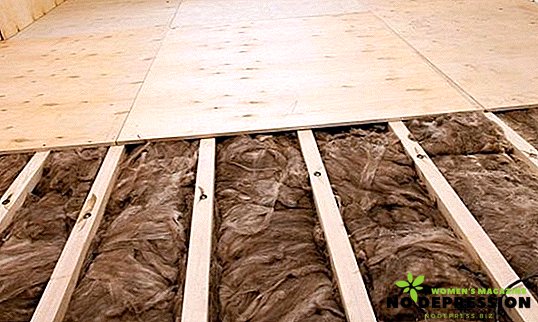High-quality floor insulation in a wooden house will reduce the cost of heating the room. To perform work, you must first select the material on the characteristics and service life. But it is also important to comply with all recommendations for installation, so that the heater will last as long as possible.

We choose material for warming
Before starting work, select the appropriate material.
There is one important point: it is possible to carry out work in a wooden house only after the wood shrinks, that is, not earlier than 6 months after the construction of the building. Otherwise, the shrinking process may spoil the material.
When choosing a material, you should pay attention to such characteristics as:
- thermal conductivity;
- weight, thickness;
- ease of installation;
- fire resistance;
- life time;
- environmental friendliness.
When working with wooden structures are important indicators such as service life and refractoriness.
Mineral wool
It is considered one of the best insulation for the floor. Benefits include:
- low thermal conductivity;
- good refractoriness;
- excellent sound insulation;
- vapor permeability;
- simple installation.
Mineral wool "breathes", passes the air, restrains the spread of flame. It is made in the form of rolls or mats. The main disadvantage is low resistance to moisture. When in contact with water, the material is deformed, loses its characteristics, therefore when using this insulation, it is necessary to properly build a waterproofing layer.

Dry gypsum fiber screed
This type of screed is made of gypsum fiber. The advantages include:
- high thermal insulation characteristics;
- resistance to fire;
- ease of installation;
- possibility of use with any floor coverings;
- small thickness;
- good noise insulation characteristics.
The main disadvantage of the material can be called a fairly high cost, as well as uneconomical use - one bag (20 kg) is enough for insulation not more than 1 square meter of surface. Also, the material is deformed by moisture.

Glass wool
Popular material for warming the floor. The advantages include:
- simple installation;
- environmental safety insulation;
- incombustibility of the material.
But the main disadvantage can be called a significant shrinkage of glass wool - in just one year the thickness of the material can be reduced to 10 cm, which leads to a violation of the integrity of the insulating layer. Also, the disadvantages include low resistance to moisture and not the highest thermal insulation characteristics.

Styrofoam
It is considered one of the most famous insulation. Attracts the best ratio of quality and price. The tool is not deformed by moisture or temperature fluctuations. Even a small thickness of insulation (10-15 cm) provides the highest quality insulation.
The disadvantages include fragility. In order for the heater to last longer, it is important to provide a high-quality insulating "pie". True material does not allow air, which is not the best impact on the tree.

Styrofoam
The advantages of extruded polystyrene include:
- resistance to fire, temperature fluctuations;
- low thermal conductivity;
- high strength.
The only disadvantage is the high cost of the material.

Technology laying insulation
Below
To obtain a high-quality result when insulating from below, you need to observe a number of nuances:
- need a two-layer insulation;
- it is necessary to reduce the loss of heat, which usually goes through the bottom;
- pre-process the wood with special means that protect from moisture and provide waterproofing.
The instruction is as follows:
- Laying waterproofing on the ground, if this layer is not. This will prevent the occurrence of moisture in the underground space.
- Stuffing on the lower part of the lag shalevki.
- Installation of vapor barrier from diffusion membranes. The main purpose of the material - the "repulsion" of moisture.
- Laying insulation layer. It should be mounted so that there are no gaps between the lags and the material.
- Above is laying vapor barrier over the insulation.
- On the top of the logs fill the bars up to 2 cm thick, due to which the material will not come into contact with the subfloor - the resulting gap will ensure air circulation.
- Installing plywood to overlap joints.
- Installation of flooring.

Among the positive aspects of this scheme can be noted:
- ceiling height will remain the same, because the material does not "eat up" the space;
- during work on the basement side, not only the floor, but also the overlap of the first floor is protected from freezing;
- the floor surface will be protected from evaporation, which minimizes the risk of rot in the wood;
- when installing in this way, it is not necessary to use rigid insulation, since it will not be under pressure from furniture, etc.
Not without flaws. For example, the installation process itself is quite laborious - the work must be led by at least two people. When performing work is limited and the choice of insulating material.
Over the top
The process of thermal insulation by this method will differ slightly from the previous one. Installation Instructions:
- The leveling of the floor by sealing cracks, removing protrusions, chips. You can use mounting foam for this.
- Installation of the lag at a distance of 45-50 cm using the construction level to check the evenness.
- Laying insulation in the resulting openings. Carry out this procedure should be as careful as possible to avoid the appearance of gaps, holes.
- Installation of plywood, and it is recommended to put the sheets so as to avoid overlapping joints.
- The top layer slots also need to be treated with foam.

This option has more advantages compared with laying the insulation material below. Pros:
- No need to purchase expensive materials and tools.
- One person is enough for work, and it is not necessary to have special skills.
The truth is, there are drawbacks, because of which many people choose the insulation of the wooden floor at the bottom (from the basement). For example, if you break the installation technology, there is a high risk to ruin the floor - the wood may start to dampen, a fungus may appear. The second disadvantage is that with time, the insulation can begin to deteriorate, which can threaten health.
It is possible to make high-quality warming of a wooden floor by own forces. You do not need to have special skills or expensive tools. You just need to follow the recommendations and strictly adhere to the algorithm of action.











